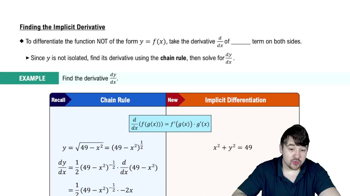Table of contents
- 0. Functions7h 52m
- Introduction to Functions16m
- Piecewise Functions10m
- Properties of Functions9m
- Common Functions1h 8m
- Transformations5m
- Combining Functions27m
- Exponent rules32m
- Exponential Functions28m
- Logarithmic Functions24m
- Properties of Logarithms34m
- Exponential & Logarithmic Equations35m
- Introduction to Trigonometric Functions38m
- Graphs of Trigonometric Functions44m
- Trigonometric Identities47m
- Inverse Trigonometric Functions48m
- 1. Limits and Continuity2h 2m
- 2. Intro to Derivatives1h 33m
- 3. Techniques of Differentiation3h 18m
- 4. Applications of Derivatives2h 38m
- 5. Graphical Applications of Derivatives6h 2m
- 6. Derivatives of Inverse, Exponential, & Logarithmic Functions2h 37m
- 7. Antiderivatives & Indefinite Integrals1h 26m
- 8. Definite Integrals4h 44m
- 9. Graphical Applications of Integrals2h 27m
- 10. Physics Applications of Integrals 2h 22m
4. Applications of Derivatives
Implicit Differentiation
Problem 3.8.42a
Textbook Question
Surface area of a cone The lateral surface area of a cone of radius r and height h (the surface area excluding the base) is A = πr√r²+h².
a. Find dr/dh for a cone with a lateral surface area of A=1500π.
 Verified step by step guidance
Verified step by step guidance1
Start with the formula for the lateral surface area of a cone: A = πr√(r² + h²). We are given that A = 1500π.
Set up the equation 1500π = πr√(r² + h²). Divide both sides by π to simplify: 1500 = r√(r² + h²).
To find dr/dh, we need to differentiate both sides of the equation with respect to h. First, express r in terms of h if possible, or use implicit differentiation.
Differentiate the equation 1500 = r√(r² + h²) with respect to h. Use the product rule and chain rule as necessary. The derivative of the left side is 0 since it's a constant.
Solve the resulting equation for dr/dh. This will involve isolating dr/dh on one side of the equation, which may require algebraic manipulation and simplification.
 Verified video answer for a similar problem:
Verified video answer for a similar problem:This video solution was recommended by our tutors as helpful for the problem above
Video duration:
6mPlay a video:
Was this helpful?
Key Concepts
Here are the essential concepts you must grasp in order to answer the question correctly.
Lateral Surface Area of a Cone
The lateral surface area of a cone is the area of the cone's curved surface, excluding the base. It is calculated using the formula A = πr√(r² + h²), where r is the radius and h is the height of the cone. Understanding this formula is essential for solving problems related to the surface area of cones.
Recommended video:

Example 1: Minimizing Surface Area
Implicit Differentiation
Implicit differentiation is a technique used to differentiate equations where the dependent and independent variables are not isolated. In this context, it allows us to find the rate of change of one variable with respect to another, such as dr/dh, without explicitly solving for one variable in terms of the other. This is particularly useful when dealing with relationships defined by equations like the surface area of a cone.
Recommended video:

Finding The Implicit Derivative
Chain Rule
The chain rule is a fundamental principle in calculus used to differentiate composite functions. It states that if a variable y depends on u, which in turn depends on x, then the derivative of y with respect to x can be found by multiplying the derivative of y with respect to u by the derivative of u with respect to x. This rule is crucial for finding derivatives like dr/dh when multiple variables are involved.
Recommended video:

Intro to the Chain Rule

 5:14m
5:14mWatch next
Master Finding The Implicit Derivative with a bite sized video explanation from Nick
Start learningRelated Videos
Related Practice


